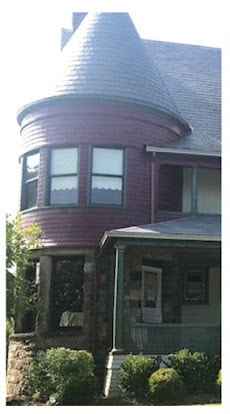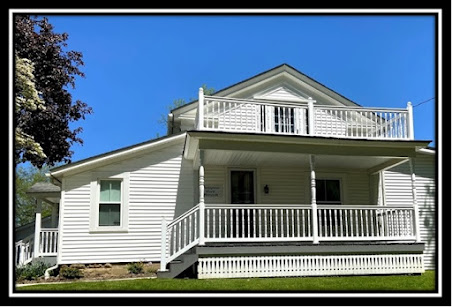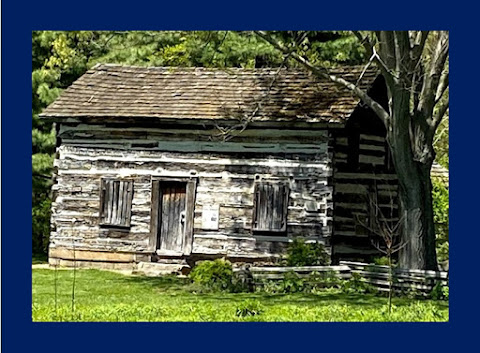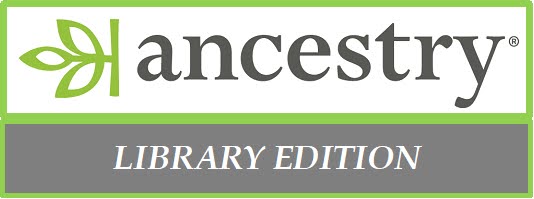Every Memorial Day in Medina, the flags unfurl, the veterans' form up, marching bands tune-up and most of Medina shows up for the annual Memorial Day Parade.
 |
| The entry to Spring Grove Cemetery |
Starting in front of the Medina Court House with the laying of the wreaths in front of the World War II Memorial, the parade winds clockwise around the square and heads east on Liberty Street to Spring Grove Cemetery where everyone gathers around the base of the Soldiers' Monument for the annual remembrance of all the military personnel who have lost their lives in service to our country.
 |
| Memorial Day 2015 |
At the center of the activities at Spring Grove Cemetery is the beautiful statue of a Civil War soldier on top of 16 foot base. A gorgeous memorial to the many soldiers who died during that bloodiest of American wars.
But what do you know of the statue? How long has it been there? How was it paid for? Who created it?
Today, we are going to delve into the history of this Medina symbol of remembrance.
Just three months after the end of the Civil War, a meeting was held at the Medina Court House on June 24th 1865, to form a Soldiers' Monument Association of Medina County to erect a monument on Public Square to honor the fallen soldiers. A committee was appointed. Fundraisers were held. Company A of the 79thth Battalion of the National Guard donated $265. A design was picked out. It was to be an eagle with a flag in its beak on a huge 10 foot square base. The editor of the Gazette urged that it was best to have one large impressive monument at the county seat that many smaller memorials scattered throughout the townships.
And then nothing happened.
Except, Chatham Township was not waiting around for the money to be raised for a monument to be erected in the village of Medina.
On July 26th of 1866, Chatham dedicated their Soldiers' Monument. It may have been the first in Medina County.
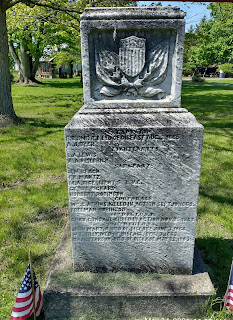 |
| This is the base of the 1866 monument in Chatham. It still stands in the village park. |
Other towns and villages were erecting monuments; Tiffin, Sandusky, New Philadelphia and Elyria all had monuments, but still nothing happened with Medina's memorial.
 |
| Mound Hill Cemetery in Seville The stone records that the flagpole was donated by a Georgia Foundation in 2009 |
In 1872, describing Seville's Memorial Day parade, the Gazette reported that the parade ended at the Mound in Mound Hill Cemetery "upon which it is the purpose of the citizens of Seville to erect a soldier's monument." It is not clear whether they ever did so. Today, this is what stands on top of the Mound in Mound Hill Cemetery.
In 1876, the County Board of Commissioners reported that they had $511.83 in donations for the purpose of erecting a Soldiers Monument at the county seat (Medina) in their annual report.
Still, nothing happened.
In 1878 an issue was put on the ballot proposing a tax to fund the erection of the Soldiers' Monument. It would have been .2 of a mill on property tax. The election was held on 8 October 1878. The proposal failed by 226 votes. Interestingly Chatham Township was one of the six locations where the issued failed heavily.
 |
| Results from the 1878 election on taxation towards the erection of a Soldiers' Monument in Medina. The underlined locations heavily defeated the measure. |
So again, nothing happened.
In 1881, the Young Men's Debating Club donated $5.30 of leftover money from their accounts to the Soldiers' Monument Fund.
Earlier, in 1878, soldiers from the Civil War met and voted to organize a "Soldiers' Union". This union later became the Grand Army of the Republic. Or G.A.R.. The G.A.R. campaigned heavily for soldiers' pensions and soldier's homes.
The G.A.R., in 1882 inquired whether it would be possible to " procure one or more condemned cannon for the soldiers' monument which will sometime be erected here." The Honorable A.S McClure of the U.S. House of Representatives agreed it should be possible. But in 1883, the U.S. Senate was concerned about how many "condemned" cannons were available to fulfill the requests coming in from across the nation. Ultimately, they postponed a decision indefinitely.
So yet again, nothing happened.
There was movement on another front. Concern had been growing about the lack of space and the proximity of the Old Town Cemetery. In 1882, "Chamberlain's Cow Pasture", 34 acres on the east edge of Medina, was purchased for $34,000. The new cemetery was named Spring Grove.
In May of 1887, The Democrat, a rival newspaper, urged that a Soldiers' Monument finally be erected. The Gazette countered that the suggestion was "not timely" but that the idea "in the near future ought to be taken hold of in earnest." They never explained why it wasn't timely or why it would be more timely "in the near future."
Less than a year later, the timing was finally right. The G.A.R got involved and things started happening:
1888
- At the March G.A.R. meeting, the post commander reported that the County Commissioners were willing to turn over the accumulated funds, now totaling $1400, to a Monument Committee. The post immediately formed a committee.
- The trustees of Spring Grove Cemetery offered the donation of a suitable plot for the placement of the monument.
- The Ladies Aid Society donated $115. Other fundraisers were held.
- In April, D. Hemmeter, a local marble cutter, traveled "east" in interest of the soldiers' monument.
- June 1 - a call went out in the Gazette asking for pledges towards the final costs, shipping and installation of the monument. Quickly 179 names appeared in the lists of subscribers, promising over $770 towards the project.
Over the next several months, more subscriber lists appeared in the Gazette, pledging another $250.
Just some of the subscribers, pledging money to the
monument Medina Gazette, June 1, 1888, page 5.- By October 19, the monument, minus the statue had arrived. The installation began. The statue arrived a few days later.
- A November 9th Gazette article reported that the dedication service was to be held on November 10th a 1 p.m.. The parade was to form up at Smith and Broadway and following the Medina Cornet Band, they were to march from Broadway to Liberty and east on Liberty to the Cemetery, much how the current parade route follows.
- However, the parade did not happen on the 10th. It was the fault of northeast Ohio's November weather - extremely heavy rains forced the postponement. It was rescheduled for the 21st of November.
- The November 23rd article described the parade route as "starting at Smith and Broadway, they marched west on Smith to Court Street, then north on Court Street to Washington. They traveled west on Washington to Prospect, and north on Prospect to Liberty, east on Liberty to Court, south on Court street to Washington, east on Washington to Broadway, north on Broadway to Liberty and east on Liberty to Spring Grove. No explanation was given for the change in route, but I have another theory to explain it.
 |
| Medina County Gazette 23 November 1888, page 1. |
- Local marble cutter, D. Hemmeter had been given to contract to oversee the project.
- The statue was made in Quincy, Massachusetts.
- The monument was made in Concord, New Hampshir.e
- The "mound" was 3 feet high and 120 feet in circumference.
- The foundation is 7 feet deep.
- The bottom base is 6"6" square and 20" thick.
- The second base is 5 feet square and 15" thick.
- The third base is 4'2" square and 19" thick.
- On the third base's faces are carved the words "Vicksburn", Chickamaugua", and "Gettysburg".
- The plinth is 3'4" square and 1 foot thick.
- The die in the center is 2'1" wide and 3'2" high and has columns at each corner. The columns are 11" in diameter
- The cap plinth is arched shaped, 3 foot square and 20 inches thick.
- The pedestal is 3' 9" high and 2'10" thick.
- The statue is 6' 6" high on a 6" base.
- The soldier stands at rest, with both hands on his musket. The cape of his overcoat is thrown over his shoulder and he wears a regulation cap.
- When first erected, the statue could be seen from Public Square. Homes and trees now obstruct that view.
 |
| Obscured by flags in preparation for Memorial Day, Litchfield's stone reads "Dedicated to our Nation's Defenders 1936" |
SOURCES:
- Bank Notes, 1 August 1950, page 3
- Cannons of Spring Grove by Nelson (Terry) Hart.
- Combination Atlas of Medina County and Ohio, 1874
- History of Medina County Medina County Historical Society, 1948.
- History of Medina County and Ohio, Baskin and Battey, 1881.
- Medina County, Coming of Age Joann King.
- Medina County Gazette
- 24 June 1865, page 3
- 1 July1865, page 3
- 2 February 1866, page 2
- 6 April 1866, page 3
- 6 July 1866, page 3
- 31 January 1868, page 3
- 7 June 1872, page 2
- 3 October 1873, page 2
- 7 December 1877, page 3
- 13 September 1878, page 6
- 11 October 1878, page 7
- 19 September 1879, page 7
- 1 April 1881, page 2
- 3 June 1881, page 7
- 28 April 1882, page 5
- 13 May 1887, page 5
- 9 March 1888, page 5
- 23 March 1888, page 5
- 20 April 1888, page 5
- 4 May 1888, page 5
- 11 May 1888, page 5
- 25 May 1888, page 5
- 1 June 1888, page 5
- 31 August 1888, page 5
- 19 October 1888, page 5
- 26 October 1888, page 5
- 9 November 1888, page 5
- 16 November 1888, page 5
- 23 November 1888, page 4
- 4 June 1937, page 4
- 29 September 1942, page 1
- 27 May 1955, page 1
- Medina County Sentinel
- 29 May 1908, page 5
- 29 May 1908, page 5
- Medina Sun
- 5 August 1999, page A3












